NARINÉE: Jewellery Inspired by Armenian Architectural and Cultural Heritage.
Narinée Tchilinguirian
A Lebanese Armenian interior architect and multitalented designer currently based in Milan, Italy. She grew up in a family of designers — her father, a jewellery designer; her mother, an interior designer and sister, a graphic designer. Her passion for design, cultural heritage and the interplay of both worlds started at a very young age and is a core part of who she is.
After studying interior architecture in Beirut and successfully completing 2 Master’s programs in Milan (an MA in Product design from Politecnico di Milano and an MA in Multidisciplinary design from Alta Scuola Politecnica), Narinée became active as a product designer, interior architect, and faculty member of the LAU Architecture department. She was however determined to make her Master’s thesis ‘Beyond traditions: Armenian Contemporary Design’ a real life project and launched her namesake brand ‘NARINÉE’ in 2015 – a jewelry collection inspired by Armenian architectural and cultural heritage and a testimonial to years of study and research.
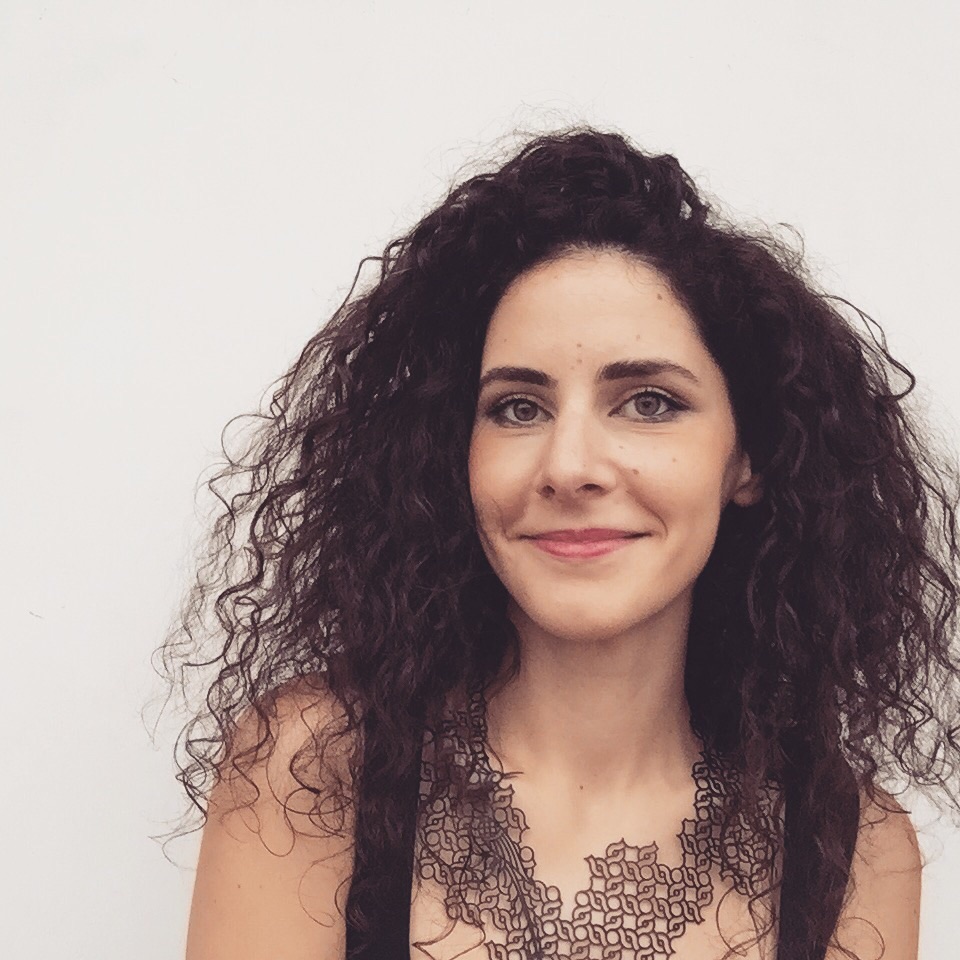
Inspirations
NARINÉE’s work is a contemporary jewellery. Her collections are inspired by Armenian architectural and cultural heritage. Ornamental carvings and multi-layering are two concepts individuated in this heritage. These jewellery pieces are therefore portrayed as ‘layers’ – with each piece uniquely curated as an aesthetically bold adornment that carries a story, a narrative, an inspiration.
Folktales, myths, symbolism (pomegranates, birds, traditional costumes, etc), culture, design and architecture are some of the common threads of Narinee’s pieces.
Inspirations: Design and Architecture
NARINÉE’s background in interior architecture influenced her approach to research and adapt the architectural stone carving patterns into creative jewellery items. She has worked with several stone carving patterns from Armenian historic sites such as Partzrakash from the 12 century, Keghart from the 10 century, Sévan also from the 12 centaury and Noravank from the 13 century.
In addition the designs incorporate layers of various bird symbols from the Armenian ornamental art, in some cases resembling a combination of fine jewellery and tattoos.
The high tech innovative manufacturing techniques, using black or coloured silicon with gold plated materials, resulted in the lace-like ornaments that are extremely thin, soft and light weight and yet have a high tensile strength.
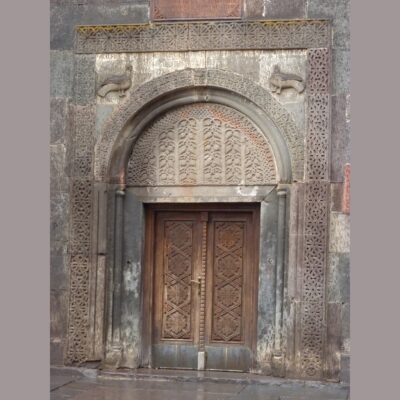
The door is the portal of the Geghard Monastery in Armenia, built in 1215.
Partzrakash’s stone carved patterns:
These pieces reflect Partzrakash’s stone carved patterns, dating back to the 12th century in Armenia, and a hidden ‘Lor’ (quail, a short-tailed bird) much present in the Armenian ornamental art and architecture.
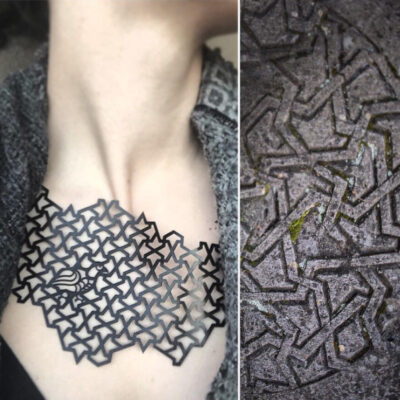
Inspiration from Partzrakash's stone carved patterns, dating back to the 12th century in Armenia, and a hidden 'Lor' (quail, a short-tailed bird) much present in the Armenian ornamental art and architecture.
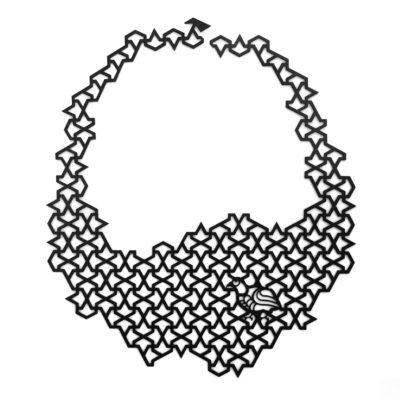
HIDDEN BIRD, black silicon, This piece reflects Partzrakash's stone carved patterns, dating back to the 12th century in Armenia, and a hidden 'Lor' (quail, a short-tailed bird) much present in the Armenian ornamental art and architecture.
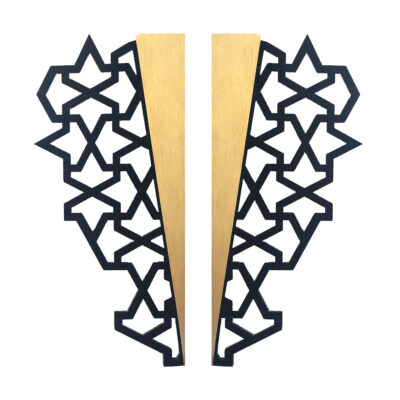
MARAL earrings, 18K gold plated brass and black silicone, motifs delineated from Partzrakash's architectural stone-carved patterns, dating back to the 12th century in Armenia.
Keghart’s Stone Carved Patterns
These pieces reflect Keghart’s stone carved patterns, dating back to the 10th century in Armenia.
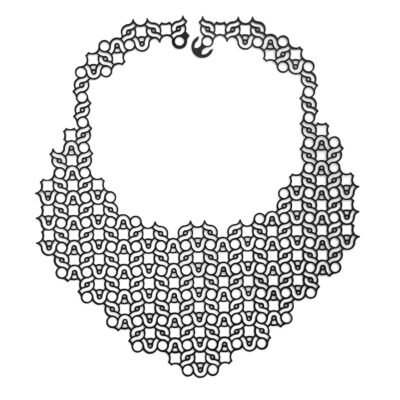
KEGHART necklace, black silicon , This piece reflects Keghart's stone carved patterns, dating back to the 10th century in Armenia.
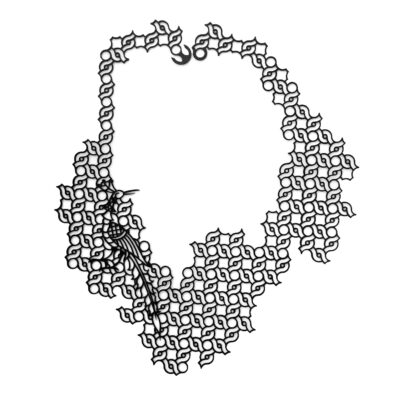
BLACK PEACOCK necklace, black silicone , This piece reflects Keghart's stone carved patterns, dating back to the 10th century, incorporating a peacock, symbol of angels and immortality in the Armenian cultural belief.
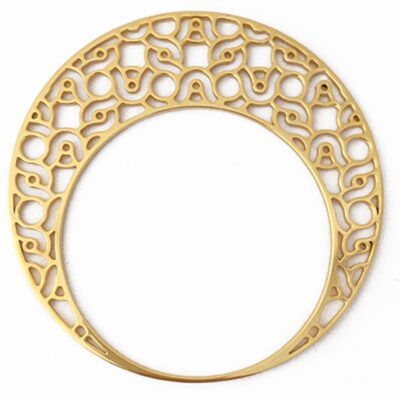
LOUSSINE bangles, 18K gold plated brass, reveals motifs delineated from Kéghart's architectural stone-carved patterns.
Sévan‘s Stone Carved Patterns
This particular piece reflects Sévan‘s stone carved patterns, dating back to the 12th century in Armenia, incorporating various bird symbols from the Armenian ornamental art.
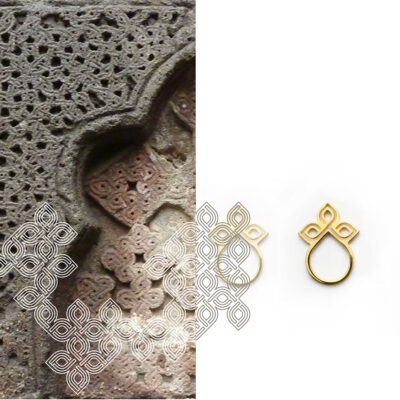
SÉVAN TRÈFLE ring, 18K gold plated brass, reveals an ornament delineated from Sévan's architectural carved-patterns, dating back to the 12th century in Armenia.
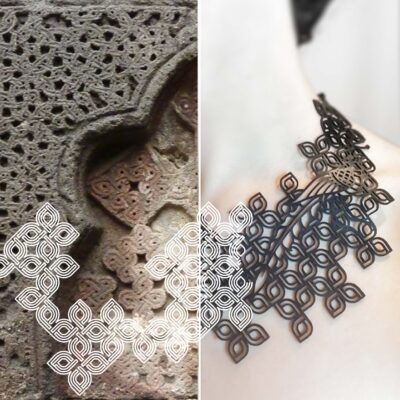
FOUR BIRDS necklace inspirational background from the Sévan Stone carved patterns.

FOUR BIRDS necklace, black silicon, reflecting Sévan's stone carved patterns, dating back to the 12th century in Armenia, incorporating various bird symbols from the Armenian ornamental art.
Noravank Stone Carved Patterns
Noravank’s architectural stone-carved patterns, dating back to the 13th century in Armenia, transformed into jewellery pieces.
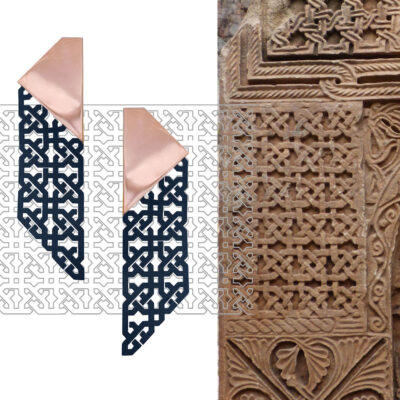
KAYANE earnings,18K gold plated brass and black silicon, motifs delineated from Noravank's architectural stone-carved patterns, dating back to the 13th century in Armenia.

NOUR money clip, 18K gold plated brass, motif a pomegranate (``Nour``), symbol of prosperity and good fortune within the Armenian culture. The back motifs delineated from Noravank's architectural stone-carved patterns, dating back to the 13th century Armenia.
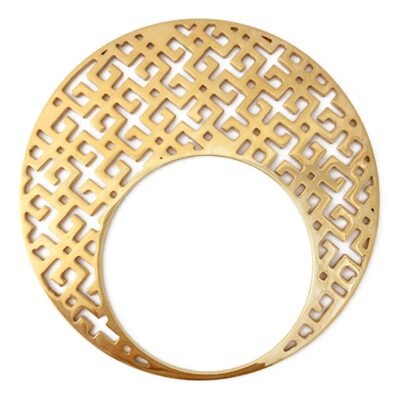
ZABEL bangles, 18K gold plated brass, Motifs delineated from Noravank's architectural stone-carved patterns, dating back to the 13th century in Armenia.
Inspirations: Armenian Traditional Costumes
Armenian Costumes reflects a rich cultural traditions that varies from one region to another and through time. The most characteristic and complex part was the headdress, it stood out for its special beauty. The head gear in particular was ornamented with coins, silver chains…etc
‘Noraloussin’ – New Moon series reflects Armenian traditional costumes. According to popular belief, the ‘noraloussin’ (new moon) brings luck, prosperity and protects its owner’s health and well being.
The ‘Ani’ series and The ‘Araks’ series of rings is inspired by the Armenian traditional head adornments, whose impactful line work is translated in this case into ring details.
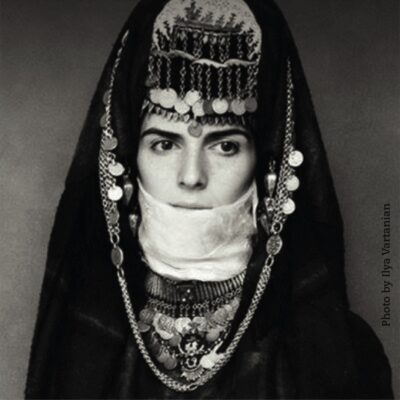
Traditional Armenian costume - by Ilya Vartanian

The 'ANI' and The 'ARAKS' series of rings is inspired by the Armenian traditional head adornments, whose impactful line work is translated here into ring details.

THE ANI rings series, 18K gold plated brass or silver or black silicon.
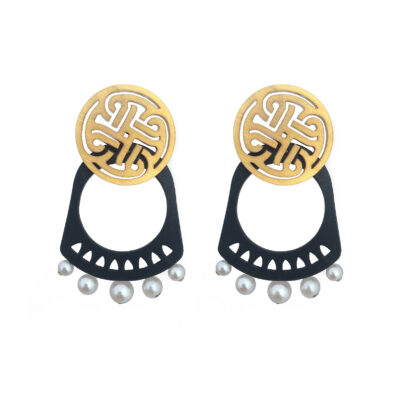
HASMIG earrings, 18K gold plated brass with black silicon and pearls. An Armenian rosette, an inspiration from the past.
Inspirations: Armenian Cultural Symbols
Peacocks and Cranes
Bird depictions are very present in the Armenian arts and culture; from ‘Trtchnakir’ (bird scripts) to ceramics, architectural stone-carvings or even folktales.
‘GROUNG’ (“gueh-roong”) or KRUNK: CRANE in Armenian – a long-legged bird – Cranes have a special significance in the Armenian culture, associated with migration and homesickness. Many traditional Armenian folk songs are dedicated to cranes, asking them to come back – bringing some news from their homes and loved ones. According to popular belief, they are also bearers of good fortune.
“SIRAMARK”: PEACOCKS in Armenian – is the symbol of angels and immortality in the Armenian cultural belief. Peacocks are often depicted in Armenian traditional art, religious manuscripts, and clothing.

Page from an Armenian manuscript dating back to 1262 AD.

GROUNG BLACK earrings, 18K gold plated brass
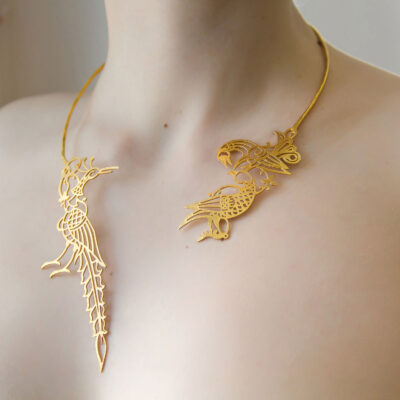
GOLD PEACOCK, 18K gold plated brass, finished by hand, with a slightly hammered and textured finish, depicts two interlacing birds facing a peacock.

ROYAL BIRDS necklace, 18K gold plated brass, finished by hand, with a slightly hammered and textured finish, representing two royal birds facing in and safeguarding their owner.
Pomegranate
In Armenian mythology the pomegranate symbolizes abundance, fertility, prosperity and good fortune. It is also believed that a mature pomegranate has 365 seeds – one for each day of the year. Over the years, Armenian artists have used the pomegranate as a theme to symbolize a spectrum of emotions – from pain to hope, rebirth and the survival of a nation.
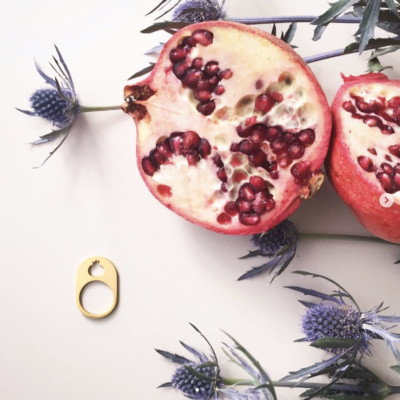
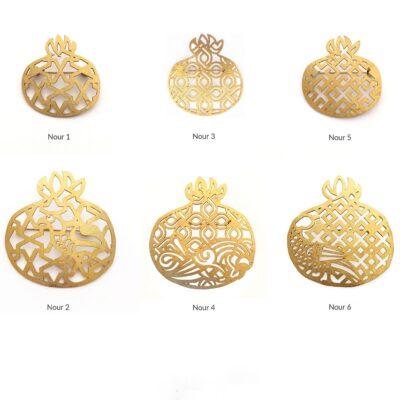
NOUR brochures collection , 18K gold plated brass slightly hammered and textured finish.
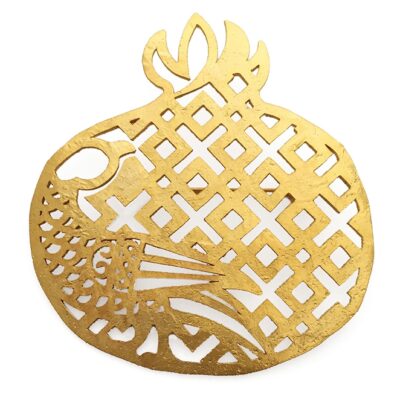
NOUR 6 brooch, 18K gold plated brass, hammered and textured finish. These pomegranate brooches reveal motifs delineated from Partzrakash's architectural stone-carved patterns, dating back to the 12th century in Dsegh, Lori province, Armenia.

NOUR pendant, 18K gold plated brass slightly hammered and textured finish with pearls.
Grapes
Grapes are one of the national symbols in the Armenian culture. A symbol of labor, wealth, prosperity and rebirth. They are naturally woven into architectural carvings, celebrated in spiritual-religious ceremonies and very much present in Armenia’s every day life and folklore.
.
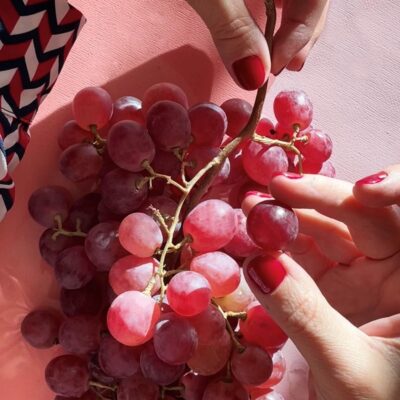
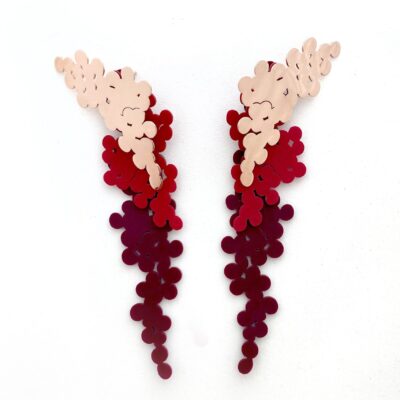
KHAGHOGH earrings, pink gold plated brass, red and purple soft silicone.

KHAGHOGH necklace, pink gold plated brass, red and purple soft silicone.
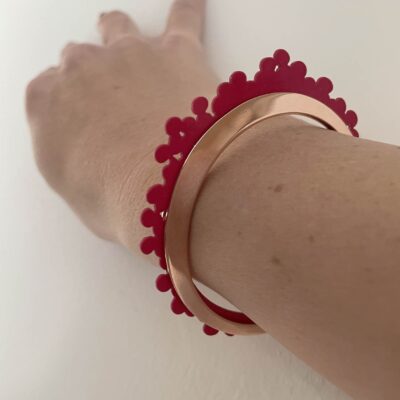
KHAGHOGH bangles, pink gold plated brass, red and purple soft silicone.
Recognitions
Within the span of a couple of years, Narinée’s collections received great exposure and recognition through the various fashion weeks and shows worldwide – Beirut, Milano, Toronto, Dubai, Bahrain, to name a few – followed by recognition and interviews in some of the biggest design magazines: Vogue, Vanity Fair, Architectural Digest, Jdeed, Sayidati, Gulf News, etc.
Materials and Techniques used by Narinée
One of Narinée’s biggest challenges was understanding the full potential of the materials she was working with: silicone, gold, brass, semi-precious stones…
Owing to her specialized education in architectural/industrial design, Narinée was able to add a touch of originality and ingenuity to her jewelry collection: bold in its unconventional marriage of materials, blending contemporary manufacturing techniques & materials with refined traditional craftsmanship and minimalistic shapes with intricate patterns.
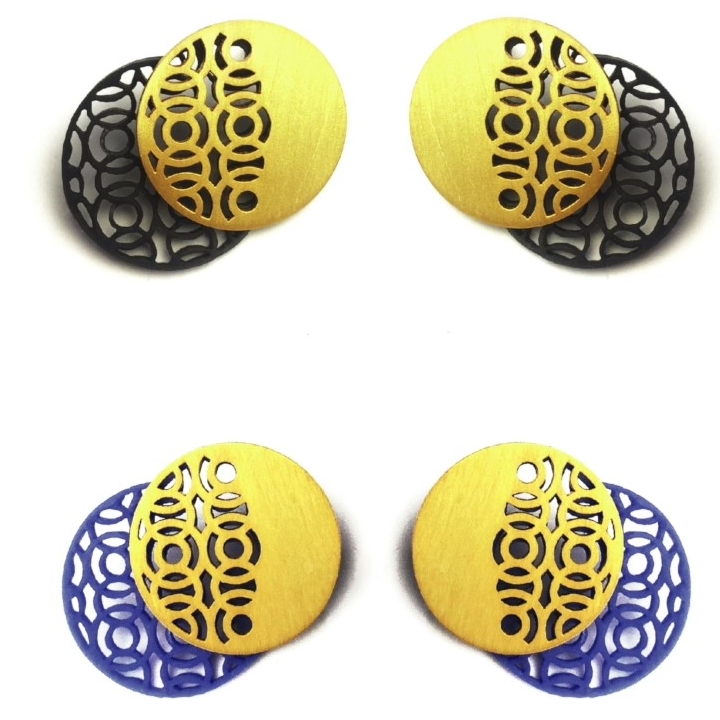
Noraloussin’ - New Moon earrings. 18K gold plated on brass with black or blue silicone.
Narinée Jewellery
After the launch of her brand in Beirut, Narinée relocated to Italy, and currently calls Milan her home. From there, she coordinates everything between North America, Europe and Middle East and travels back and forth to collaborate with specialised artisans and refine her craft.
For each new collection, she researches, designs prototypes and then closely collaborates with the artisans on the manufacturing process. She is deeply involved in every step of production to redefine and improve the details and quality of each piece. Each piece is then wrapped in its unique packaging, accompanied by an explanatory leaflet and is shipped worldwide, sharing a part of this cultural heritage.
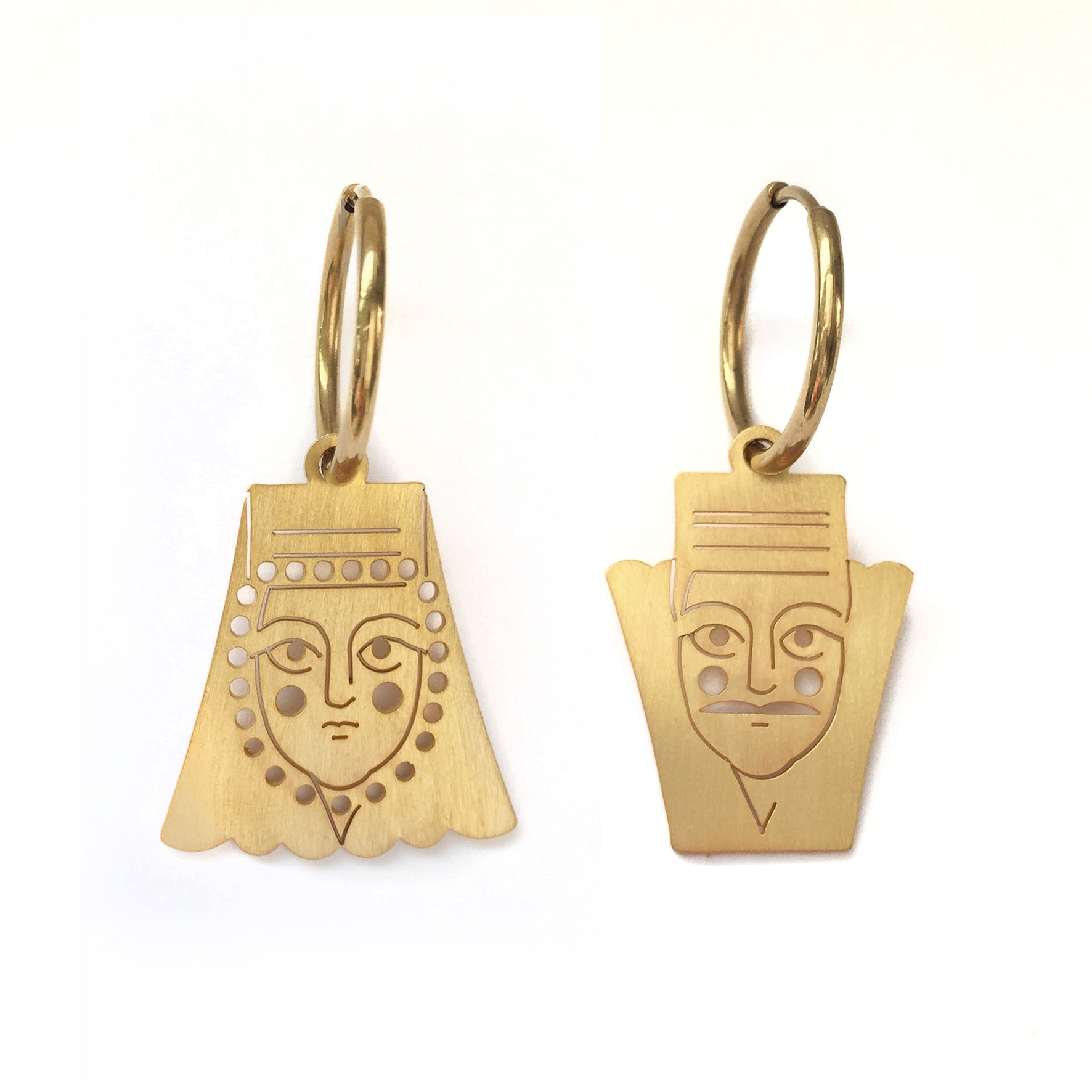
Dadig- Babig' (տատիկ-պապիկ) - which translates as grandmother and grandfather - Earrings 18K gold plated brass.
